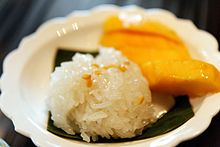Mango sticky rice
 Sliced mango served with Thai sticky rice | |
| Alternative names | Khaoniao mamuang |
|---|---|
| Course | Dessert |
| Place of origin | Thailand |
| Main ingredients | Sticky rice, mango, coconut milk |
Mango sticky rice (Thai: ข้าวเหนียวมะม่วง, RTGS: khaoniao mamuang, pronounced [kʰâ(ː)w.nǐa̯w mā.mûa̯ŋ]) is a traditional Thai dessert made with glutinous rice, fresh mango and coconut milk, and eaten with a fork, spoon, or sometimes the hands.[1] Although originating in Thailand, it is consumed throughout the Indochina region of Southeast Asia, including Laos, Cambodia, and Vietnam. [2] Mango sticky rice is usually eaten in the peak mango season, the summer months of April and May in Thailand.[3] The notable mango sticky rice shops in Bangkok such as the Wong Wian Yi Sip Song Karakadakhom neighborhood in Pom Prap Sattru Phai near Hua Lamphong, which will only sell for 4 months per year (February to June)[4], and at the Samphrang neighborhood in Phra Nakhon near Giant Swing and Chao Por Suea Joss House, with the Ban Mo near Si Kak Phraya Si Intersection and Pak Khlong Talat etc.[5] [6]
Method of preparation
The main ingredients needed are sticky rice (glutinous rice), canned or fresh coconut milk, salt, palm sugar and mangoes. To prepare the dish, the rice is soaked in water and then cooked by steaming or the use of a rice cooker. Meanwhile, the coconut milk is mixed with salt and sugar, and heated without boiling. After the rice is finished cooking, the coconut milk mixture and the rice are mixed together evenly and allowed to sit to allow the milk to absorb into the rice. The mangos are peeled and sliced. To serve the dish, the rice is scooped onto a plate, a few mango slices are placed on top or to the side, and the remaining coconut milk is drizzled on top. Sometimes the sticky rice is topped with crispy yellow mung beans. [7]
Mostly, yellow mango is used which has a sweeter taste than green mango. Traditionally, the Nam Doc Mai (flower nectar mango) and ok-rong varieties of mango are used.[4] Red/orange mangoes from Mexico & the Caribbean can also be used.[8] Glutinous sticky rice, which is sweeter than the normal sticky rice, is used for the best texture. [7]
As with many rice-based desserts, it is best to eat mango sticky rice directly after it is purchased or cooked because when refrigerated, the glutinous sticky rice turns hard and the coconut milk expires quickly. [9]
Variations
These are some variations to the classic mango sticky rice:
- Substitute half the white sticky rice with black Thai sticky rice to get a nice purple color.[10]
See also
Sticky rice is also commonly used in many sorts of Thai desserts like Khao mak and Khao tom. [7]
References
- ^ "What Is Mango Sticky Rice?". wiseGEEK. Retrieved 29 May 2015.
- ^ "Mango Sticky Rice". Rasa Malaysia. Retrieved 29 May 2015.
- ^ "Mango on Sticky Rice Recipe". Natty Netsuwan. Retrieved 6 March 2017.
- ^ a b "สนามข่าวชวนกิน : พาไปชิม! ข้าวเหนียวมะม่วง ป้าใหญ่ ป้าเล็ก". Channel 7 (in Thai). 2018-03-10.
- ^ "ก.พานิช". Sanook (in Thai). 2013-05-16.
- ^ laser (2009-05-18). "เที่ยวไปกินไป @ บ้านหม้อ". Pantip.com (in Thai).
- ^ a b c "Thai Mango Sticky Rice Recipe". Mark Wiens. Retrieved 6 March 2017.
- ^ "ข้าวเหนียวมะม่วงสูตรพี่ปู ฯ". Bloggang (in Thai). 2011-01-29.
- ^ "Mango with Sticky Rice". Realthairecipes.com. Retrieved 6 March 2017.
- ^ "Coconut Milk Sticky Rice with Mangoes". Epicurious.com. 16 May 2006. Retrieved 21 December 2017.

